Tag: interview
-
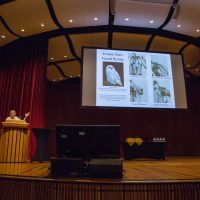 Collaborations transcend scales: In conversation with Professor Lorna Gibson2018-10-10, Author: Demi Fang
Collaborations transcend scales: In conversation with Professor Lorna Gibson2018-10-10, Author: Demi FangProfessor Lorna Gibson graduated in Civil Engineering from the University of Toronto and obtained her Ph.D. from the University of Cambridge. She was an Assistant Professor in Civil Engineering at the University of British Columbia for two years before moving to MIT, where she is currently the Matoula S. Salapatas Professor of Materials Science and Engineering. Her research interests focus on the mechanics of materials with a cellular structure such as engineering honeycombs and foams, natural materials such as wood, leaves and bamboo and medical materials such as trabecular bone and tissue engineering scaffolds. She is the co-author of Cellular Solids: Structure and Properties (with MF Ashby) and of Cellular Materials in Nature and Medicine (with MF Ashby and BA Harley).
Recent projects include studies of balsa as a model for bioinspired design of engineering materials and structural bamboo products, analogous to wood products such as oriented strand board. She teaches two subjects: Mechanical Behavior of Materials and Cellular Solids: Structure, Properties and Applications; both are also offered online through edX.
Gibson is a MacVicar Faculty Fellow, MIT’s top award for undergraduate teaching. She has served as Chair of the Gender Equity Committee in the School of Engineering, Chair of the Faculty, and Associate Provost at MIT.
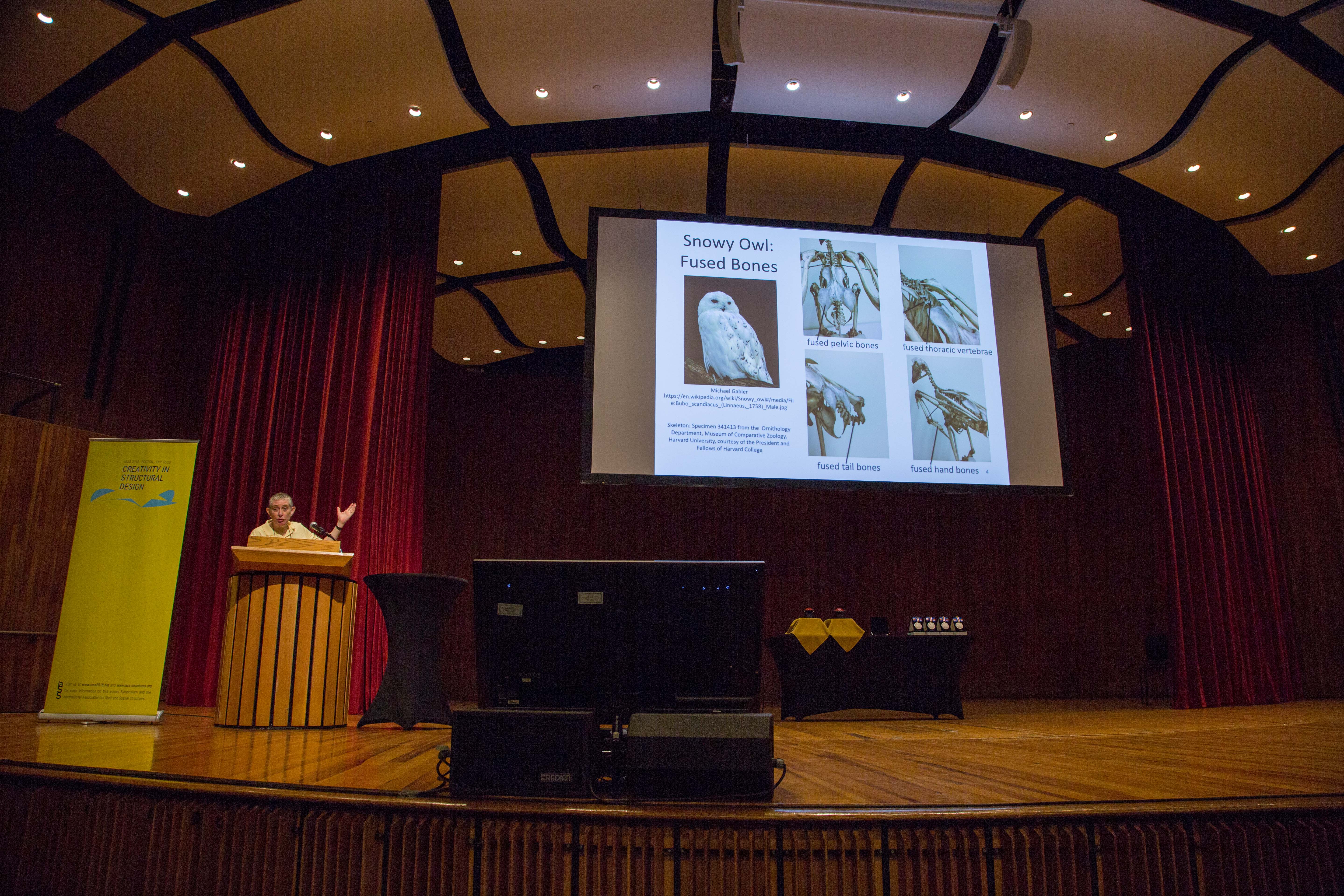
Professor Lorna Gibson gives a keynote at IASS 2018, hosted at MIT.Demi Fang: The theme of the conference is “Creativity in Structural Design.” How do you interpret this theme? What does it bring to mind?
Lorna Gibson: I’ve looked at a lot of natural materials. I look at how they behave mechanically and see what their natural mechanisms of deformation and failure are, and then to try to see what we can learn from those materials for engineering design. This bio-inspired design approach is one we share with a lot of other people.
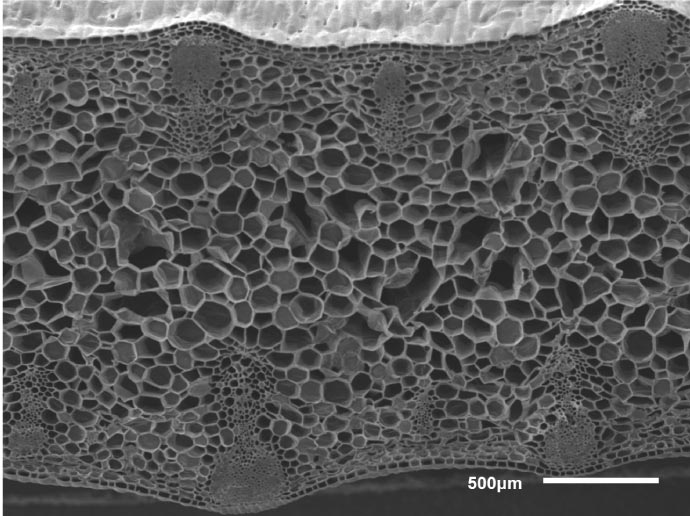
Cellular structures in plants: cross-section of an iris leaf. (Microscopy: Don Galler)DF: What methods do you use to fuel creativity? In what ways do you blend the technical and creative aspects of your work?
LG: I think creativity often arises from doing interdisciplinary things. You become an expert in one field, but then you look at other fields and see they have different ways of doing things: they look at problems differently, or they have different kinds of problems. The way you approach things in a different field makes you rethink in your own field. I think having interdisciplinary research and having people collaborate from different fields is one way that people can be creative.
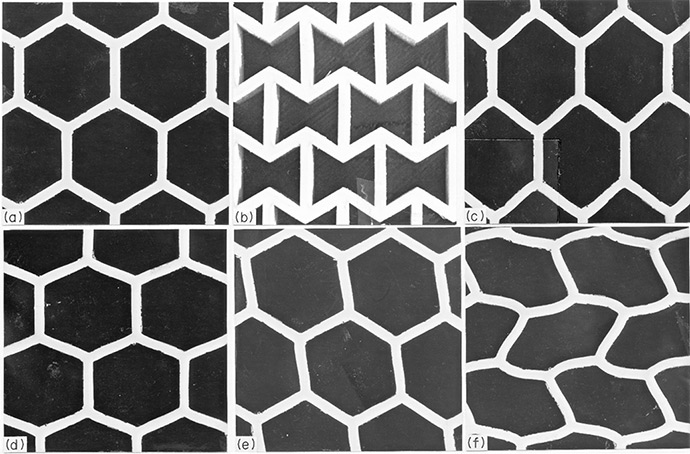
Engineering honeycombs and foams: elastomeric polymers, undeformed (a, b) and deformed in-plane (c-f). L. J. Gibson and M. F. Ashby, Cellular Solids: Structure and Properties, 2 edition. Cambridge: Cambridge University Press, 1999.DF: Describe the collaborations in your work.
LG: In our bamboo project, we collaborated with architects in Cambridge and with a wood scientist at the University of British Columbia. The architects were interested in large-scale members, thinking about how the members would be used in actual design and building codes. The wood scientist was interested in the processing of the bamboo; he had worked on the processing of wood composites like oriented strand board (OSB), the particle board, so he took what he knew about processing wood and applied it to the bamboo. Our contribution from MIT was looking at the material science of the bamboo—modeling the microstructure and the mechanical properties of the material. The nice thing about the project was that it went from looking at the microscopic structure of the bamboo, to looking at how you could process the bamboo, to looking at how you would actually use it in a building. It’s too difficult for a single person to span all those different areas of expertise, but by collaborating, we were able to do that.
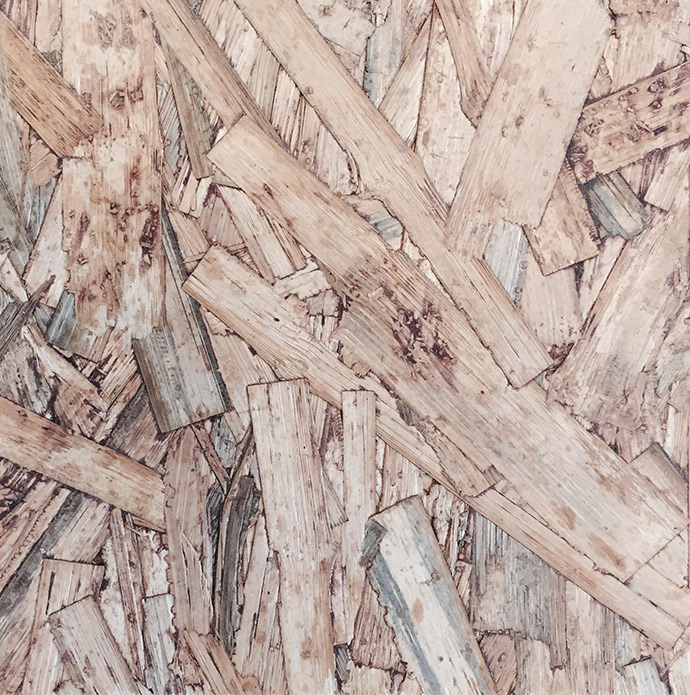
Bamboo oriented strand board, fabricated by Dr. Greg Smith’s group at University of British Columbia.DF: What are are some pressing, interesting technical challenges that you anticipate in the future in your field?
LG: My field is cellular materials—porous materials like honeycombs and foams. There’s a lot of interest right now in lattice materials, these three-dimensional truss materials, and in how to optimize these materials, optimize their structure, optimize the material you make them from, make them at smaller length scales... I think there’s still a lot of work that remains to be done in that area. There’s also a lot of interest in natural cellular materials—we worked on bamboo, but there’s also trabecular bone, wood, and plant structures. Some of these have very complex structures and I think people will continue working on them.
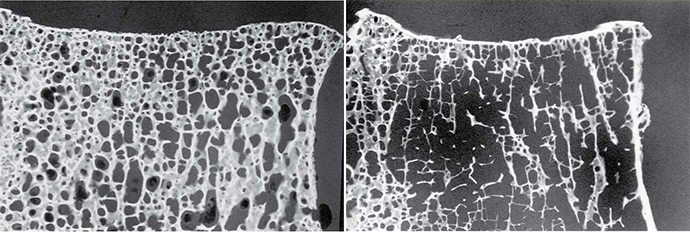
Trabecular bone is porous bone found at the ends of long bones and within the vertebrae, skull, and pelvis. Micrograph of cross-sections of lumbar vertebrae of a 55-year-old woman (left) and an 86-year-old woman (right). S. Vajjhala, A. M. Kraynik, and L. J. Gibson, “A cellular solid model for modulus reduction due to resorption of trabeculae in bone,” J Biomech Eng, vol. 122, no. 5, pp. 511–515, Oct. 2000.DF: Describe the impact of your work outside of academia.
LG: I’ve written several books on cellular solids and they’ve been quite widely used in industry. Outside of my research, I also worked a lot on equity issues for women here at MIT. Each of MIT’s five schools had a committee to help report on the status of women faculty at MIT; I chaired the committee in the school of Engineering. [These efforts resulted in the 2002 Reports of the Committees on the Status of Women Faculty.] I think the collective impact of all of those efforts really had a lot of effect at a lot of places, both in academia and in government and in industry. At the time, it got a tremendous amount of press. The president of MIT, Chuck Vest, had admitted that MIT had discriminated against women faculty, and he and his administration were willing to do things to change MIT. I think that got a lot of attention in lots of places.
Is it perfect now? No, but when I look at what things were like when I was a student – not here, but in Toronto – back then, and what it was like when I came to MIT, and what it’s like now at MIT, it’s totally different.
DF: What advice would you give to your past self or to today’s students?
LG: When I was a graduate student [at the University of Cambridge], my adviser Mike Ashby had been interested in developing this project on cellular solids. He had had a couple of undergraduate students do a senior thesis project on it, but he couldn’t get any graduate students to work on it; nobody wanted to do it with him because it wasn’t a hot, trendy topic at the time (e.g. fracture mechanics, composites). I wasn’t thinking necessarily about becoming a professor and wasn’t worried too much about what I was going to do with it; it just seemed like a really interesting project. My background was in civil engineering, and the topic was like structures but on a tiny length scale.
I worked on it because I thought it was a really interesting project. My thinking was that I’ll learn a lot, and whatever I learn I can apply to the next thing. I never really anticipated I would spend decades after that working on cellular solids! So you don’t always have to do the hot, trendy topic; it’s okay – almost better – to do what’s not hot and trendy because then you can make a big impact developing something new.
DF: What is something you are currently working on that excites you?
LG: I’ve been particularly involved with online teaching on MITx [MIT’s free online courses on edX]. We made a series of videos on how woodpeckers avoid brain injury as part of MITx, and I’d like to make some more videos like that.
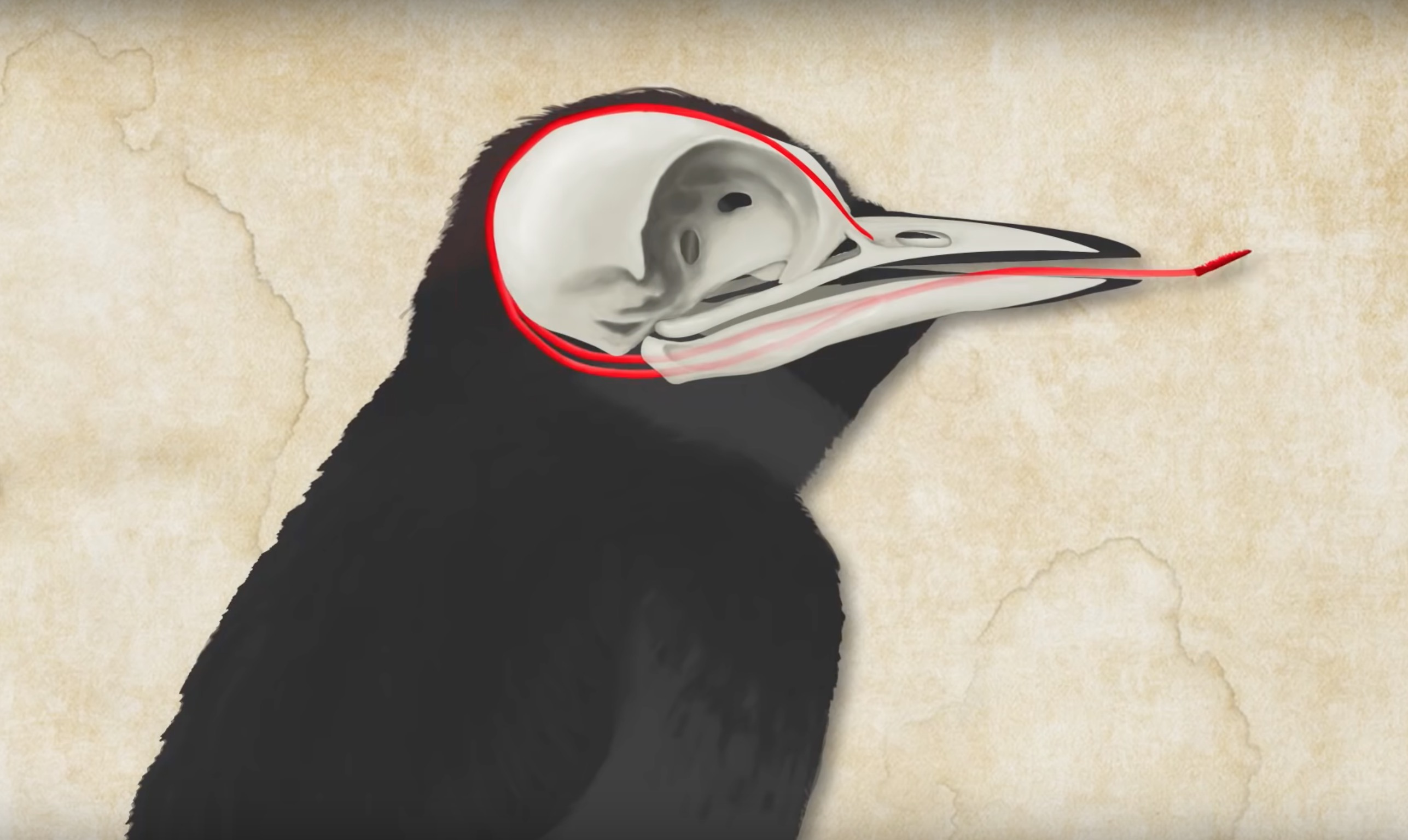
Still from Gibson’s “Built to Peck: How Woodpeckers Avoid Brain Injury” MITx series, 2016.DF: How did you get into studying birds?
LG: I’m an amateur bird-watcher, but I like natural history and I like nature. When I was a student, somebody visited our lab and said that woodpeckers had a special cellular material that protected their brains from injury, and that’s how I got interested in the woodpecking thing. There is no such material in their heads. But then I got curious about what was going on instead.
This interview originally appeared in the proceedings for IASS 2018 at which the interviewee was a keynote speaker. These interviews make their first appearance online in this co-published series between this blog and the Form Finding Lab blog with the aim of inspiring a broader audience with the thoughts and insights of these outstanding individuals. Stay tuned on both blogs for more!
More in the series: Neri Oxman | Janet Echelman | Tomohiro Tachi
-
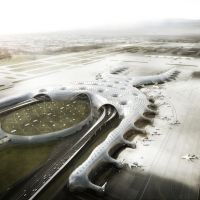 “Always question your own preconceptions”: Discussing the future of technology in architecture with Martha Tsigkari of Foster + Partners2018-02-15, Author: Demi Fang
“Always question your own preconceptions”: Discussing the future of technology in architecture with Martha Tsigkari of Foster + Partners2018-02-15, Author: Demi FangAmidst the excitement of ACADIA 2017 on MIT’s campus, we found an opportunity to sit down and chat with Martha Tsigkari, who presented the New International Airport Mexico City (2020) with her colleagues. Tsigkari trained as an architect-engineer in Greece before obtaining a master’s degree at The Bartlett’s Architectural Computation programme at UCL, which she describes as “a computer science course for designers and architects.” She has been at the Applied Research + Development (AR+D) group at Foster + Partners’ London office ever since. In this post, we synthesize some of her thoughts on the future of technology in architecture, on the art of collaborating across disciplines, and on the humility necessary for innovation. Quotes have been edited for clarity.
The main focus of Tsigkari’s role and presentation of Foster + Partners’ highly anticipated New International Airport Mexico City was “evidence in performance-driven design. It’s all about how all the analysis and optimization can be incorporated through the life of the model to make for a better solution,” Tsigkari says.
On working with Arup, the engineers on the airport project, Tsigkari says that “it was a fantastic collaboration. The design process was not conventional in that we knew how we wanted the space frame to look aesthetically, so we developed all the processes necessary to create a structurally viable and well-performing space frame. Arup was confident in the processes we had and fully adapted our topology. They would receive our permutations of the final model, analyze them, and return with the sizes of the nodes and elements required. From that feedback we would make some aesthetic decisions; if we saw some really big nodes, for example, we knew that we had to do something with the topology and the smoothing of the space frame at that location.”
 New International Airport Mexico City. Copyright Foster + Partners
New International Airport Mexico City. Copyright Foster + PartnersAside from performance-based design, the AR+D group at Foster + Partners focuses on multi-faceted and cutting-edge topics. “We see a huge future within architecture in Virtual Reality (VR),” Tsigkari says. “We also do a lot with simulations and optimization; we have written our own simulation engines that run tens or hundreds of times faster than those in the industry. I worked a lot with interoperability - making sure that this simulation works with all the different platforms that we’re using and that they talk with each other. We’re using those tools through optimization processes, whether it’s cognitive computing or genetic algorithms.
“We are also quite heavily involved with innovative interfaces to help designers understand the repercussions of their decisions very early on in the design process,” says Tsigkari. “We’re doing a lot of things with innovative materials and design-to-fabrication processes as well as looking into interesting things like the Internet of Things, seeing how we can make smarter buildings and cities that not only get constant feedback from the experiences that people have, but also better themselves without human input.
Tsigkari emphasizes the significance of nonlinear analyses and adaptive processes in future steps to improve the built environment. “There is a fundamental problem in the way we design most of our buildings: typically, it is a linear analysis for a specific pseudo-optimal state. For example, we design buildings based on the worst-case scenario of an earthquake. The resulting design is going to be useless for 90% of the time - it is only useful for the one-off chance that an earthquake happens. On the other hand, if you see how nature works, and if you embrace the idea of compliant mechanisms and nonlinear analysis, then you start embracing the ideas of embodied computation that Axel Kilian was explores in his tower, where you don’t optimize based on worst-case scenarios but instead try to design a form intelligent enough to optimize itself based on the feedback it gets and based on a specific state it always needs to return to. For me, this idea is extremely crucial. It feels like a natural next step in how we build.”
Tsigkari goes on to describe an ongoing research collaboration with Autodesk’s Panos Michalatos, Matt Jezyk and Amira Abdel-Rahmani: “We are essentially running nonlinear analyses for compliant mechanisms on the material level. More specifically, we are working with thermally actuated laminates. You can see situations where a facade is no longer a static element, but is externally actuated and adapts.
“A big part of our research right now is to understand the laminate layering required for the desired adaptations. My colleague Marcin Kosicki has been working with TensorFlow to develop a neural network, feeding in different laminates and the associated disfiguration of the material.”
Tsigkari maintains a humble, if not borderline cynical, perspective on the state of technology in architecture today. “Architecture as a profession is, I daresay, backward-looking. The industry is we are very slow to adapt to new technologies. It’s interesting to see that in the past decade, there has been a significant shift towards more computational design processes. I think what made the shift is the development of tools - for example, Grasshopper for Rhino - which made visual scripting quite intuitive. It introduced a different interface for users towards computer-science-based processes.”
How does Tsigkari train students towards such a rapidly evolving field? “What I learned at The Bartlett was not a particular software but computer science and algorithms: how to write a vanilla AI algorithm and how to potentially apply this to design problems. The trick is to get the underlying knowledge of what these processes are and how they could be used. You can use that knowledge in whatever software you want as long as you know what it is, how it works, and what you can expect from it.
“If what we see in Grasshopper is the skin of computational design, what we’re teaching is the bones and muscles of it; the underlying principles of computation. We are teaching algorithms that are not new - other fields have been using these for the past 60 years. In architecture we have started using them in the past decade. The reality is that we’re 60 years behind industries like rocket science, the chemical industries, or the army. It’s interesting to see how people feel extremely proud of using tools that have been around for over half a century and have been successfully used in many other industries with quite innovative outcomes.”
The interdisciplinary nature of the AR+D team helps. “We have people who have architectural backgrounds or engineering backgrounds, or both, but we also have artists, computer scientists, aeronautical engineers... I think that looking at what is achieved in other industries is absolutely key to being able to innovate within our own industry in terms of building processes, materials, and even techniques. Only now are we starting to look at how swarm robotics can affect buildings; techniques like these have been used extensively in other industries in the past with fantastic results. This kind of cross-referencing that can be beneficial for our industry.”
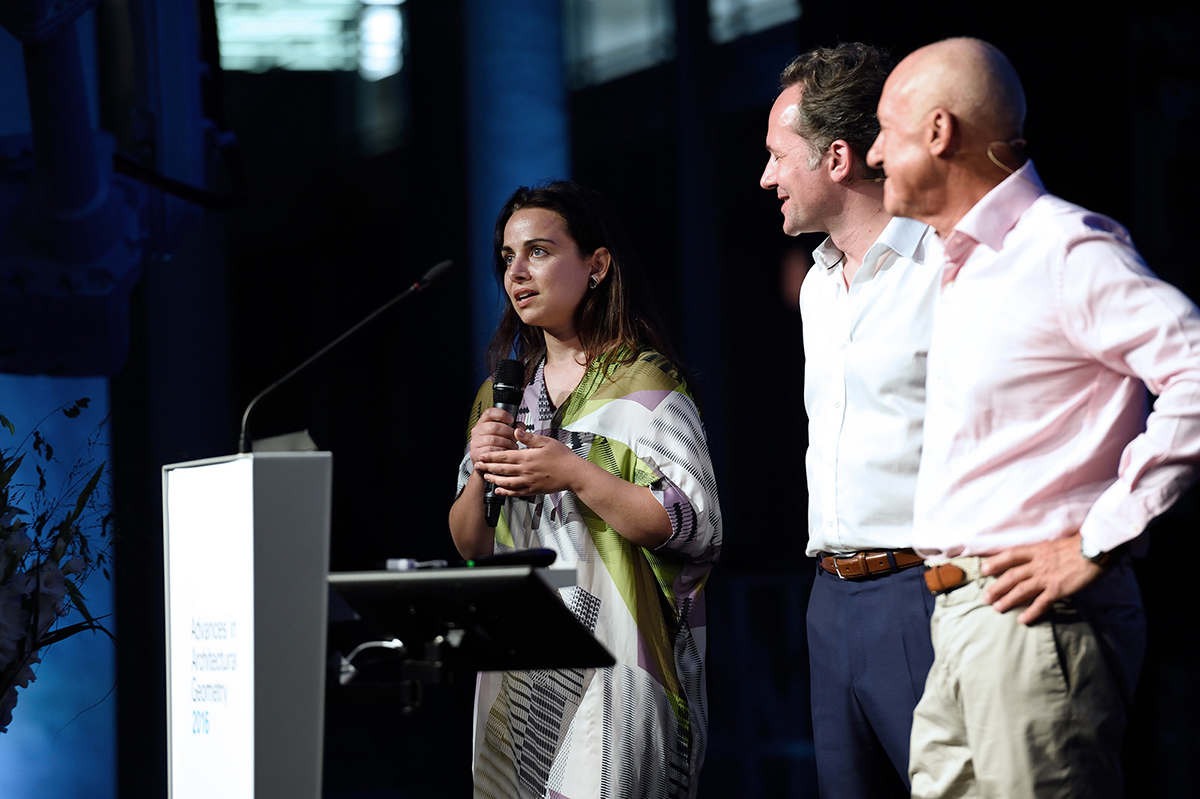 Martha Tsigkari with Francis Aish and Norman Foster at the keynote of Architectural Advances in Geometry Symposium 2016. Image courtesy of AAG 2016
Martha Tsigkari with Francis Aish and Norman Foster at the keynote of Architectural Advances in Geometry Symposium 2016. Image courtesy of AAG 2016It is by chance that Tsigkari occupies an unusual career path at the intersection of practice and academia. “My involvement with teaching is really driven by my late mentor, Alasdair Turner. He initiated the master’s programme I’m teaching at now, and he was this fantastic personality - a computer scientist, who had a lot of interest in tying computer science, architecture, and philosophy together.
“Alasdair took me from a world where I was unsure where I wanted to be and led me down a rabbit-hole to a completely different world of possibilities. After his untimely death, I kind of took over his lectures on genetic programming. For me, teaching is about extending his legacy to the newer generations, helping people the same way I was helped, to understand the art of the possible. So that’s how I ended up in academia.
“I actually find it extremely hard to be both in academia and in industry because they’re both very time-consuming. You need to be very strict with your time,” says Tsigkari. “Having said that, it gives fantastic opportunities to educate newer generations with notions you have in industry. I do not simply show my students an algorithm, but I can also show them its potential by showing them the projects I’ve used it on. It gives people a direct connection between the algorithm (which is quite abstract) and what can be done with it (which is quite tangible). I find that this connection is really interesting, and it’s very interesting for the students as well. I’ve always gotten very positive feedback about having that understanding.
Asked to give advice to students aspiring to be architects or engineers, Tsigkari pauses and admits, “This is a very difficult question. I’m horrible at giving advice; I feel that people should be their own advisers and they should do what feels right for them.”
Despite these comments, Tsigkari gradually offers some striking pieces of advice as she continues. “I think you should always do what feels right for you, and that you should always question everything. I would say you should also always question your own preconceptions of what things are. So if you are on the verge between architecture and engineering, question what these two mean for you. Your preconceptions are going to lead you down one road that may not be what you think it was. Step back; don’t make big plans. Feel your way through things that you’re interested in, and something will always come up.”
Citing her own experience, Tsigkari recalls that “as with everything in my life, I had no plans. I never saw myself in a certain position, ever. Other people had plans for me, which I had never followed. I went to a very traditional school, and I learned a lot, but they were not things I wanted to to do for the rest of my life. I mutated, diversified, and changed myself in order to pursue what I wanted.”
Tsigkari continues, “If I were to advise something, it would be to not tag yourself. Do not call yourself an architect or an engineer or a computer scientist - nowadays, I think the da Vincian perception of a person is what is closer to what we need in order to innovate. It is important to understand various disciplines while always saying to yourself that you know very, very little. That will always drive you to become better. It will take the danger out of what you do and will make a better person out of you.
“I look back at my university years with a sense of newfound introspection. Had I known then what I know now, I would never have chosen architecture - never. I would possibly go into artificial intelligence, robotics, or neuroscience, and do something completely different, because I see even now that these are the things that are interesting to me.”
Reflecting briefly on the direction in which she hopes to steer her future, Tsigkari continues, “I guess that I am trying to shift my path towards those topics that I am interested in. It becomes more difficult as time goes by and you get more responsibility at work, but, you know... I don’t think it’s ever too late.”
-
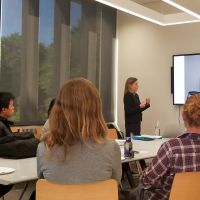 Interdisciplinary Innovation: A Closer Look at Shaping Ultra-Thin Glass with Sophie Pennetier2017-10-04, Authors: Pierre Cuvilliers Demi Fang
Interdisciplinary Innovation: A Closer Look at Shaping Ultra-Thin Glass with Sophie Pennetier2017-10-04, Authors: Pierre Cuvilliers Demi FangStructural engineer Sophie Pennetier has worked on a wide range of specialty structures ranging from the National Museum of African American History and Culture to the Mexico City Airport in firms such as RFR, Guy Nordenson and Associates, SHoP Construction, and Arup. Beyond this accomplished track record in structural engineering, all within ten years of graduating from university, Pennetier has already begun to challenge the boundaries of the role of the engineer.
A recipient of the Jerry Raphael fellowship from the Metropolitan Contemporary Glass Group and Urban Glass Brooklyn in 2016, Pennetier was awarded the opportunity to explore the possibilities in cold bent ultra-thin glass and to apply the knowledge as her own “designer, engineer, and maker” of a small glass sculpture. The process was additionally supported by Corning Inc, Coresix Inc, and Arup. Pennetier stopped by MIT in early October to give us a presentation on “Shaping Ultra-Thin Glass.” She shared with us the process of developing of her project, including steps such as testing, design, analysis, and fabrication. She also (bravely) entrusted us with handling a few samples of the glass to feel its flexibility. We sat down with her afterwards to chat about her experiences, her career, and her thoughts.
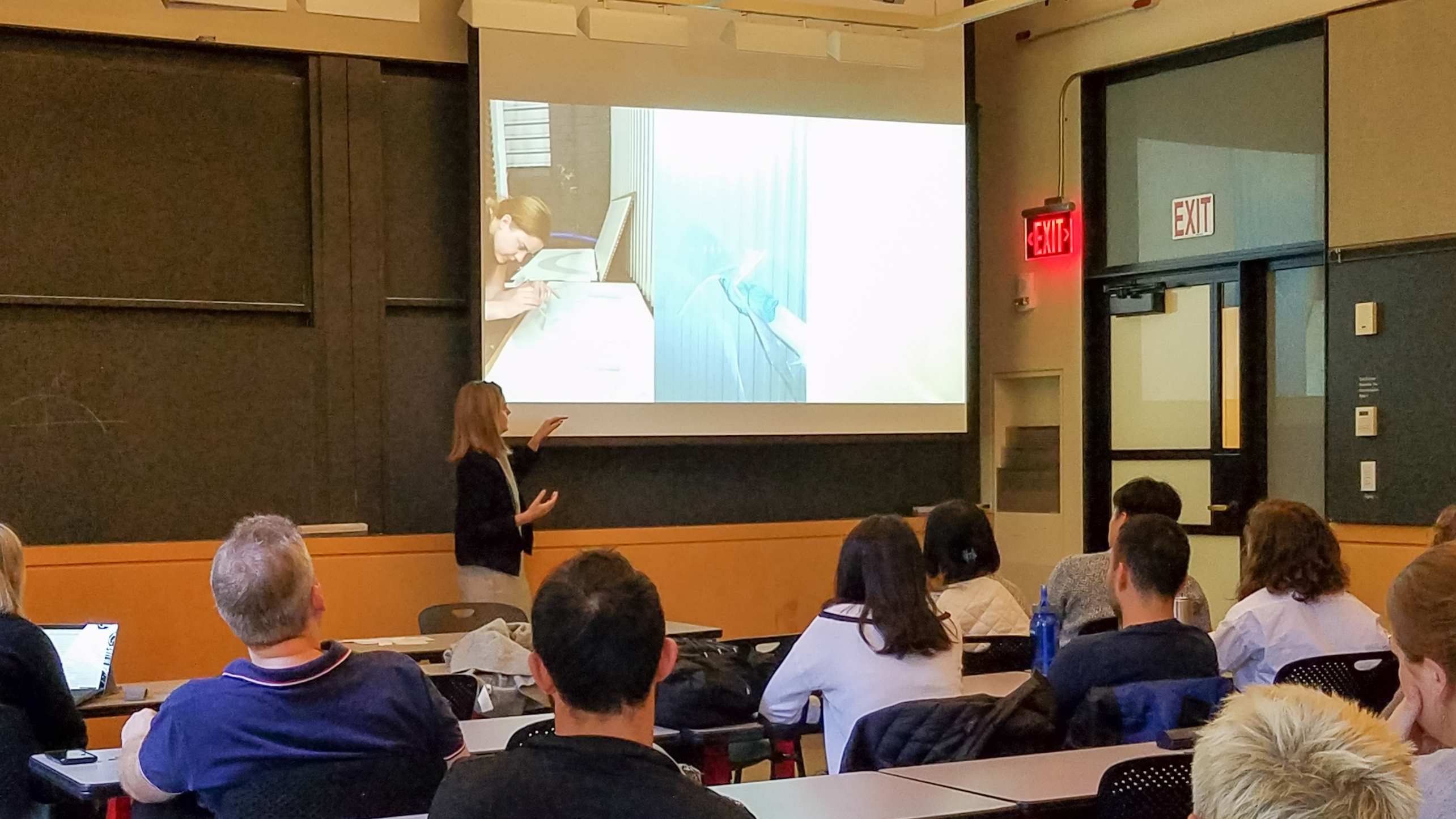
Pennetier presents her work in ultra-thin glass to master's of architecture students in Prof. Caitlin Mueller's Building Structural Systems II class.
While Pennetier’s sculpture project has greatly benefited from her background as a structural engineer, the work undoubtedly sits on the cusp of art and engineering. She cites Irish structural engineer Peter Rice as an inspiration. “One project I find particularly poetic is the Théâtre de la pleine Lune, the Full Moon Theatre (Saint-Andre-de-Bueges, France, 1992), which is a stage lit by moonlight. Mirrors are oriented such that it captures moonlight and reflects it onto the stage. It’s very inspiring that Rice worked on that project as an engineer. I think it’s essential to be at the border of art and engineering so that we can keep making buildings that inspire us, rather than just containers.”
As elegant as her sculpture is, the project also represents an innovative step. “Ultra-thin glass is particularly lightweight, clear, and scratch-resistant. Corning invented this material decades ago and yet at the time there was no application for it. In parallel, at least two markets are interested in the material: the automotive industry and the electronics industry. The automotive industry is looking to make lighter cars that are still robust enough for security, while the electronics industry is interested in making lighter, clearer, scratch-resistant electronics with the glass.” Pennetier explains that as a company, Corning maintains a hopeful eye on steering the material into the automotive market, which will likely have a quicker and larger return investment than the field of architecture. In contrast, buildings using this material may remain few and far between for now.
Does Pennetier mind that the built environment may not be the primary application for her research? A believer in interdisciplinary innovation, Pennetier points out that Peter Rice’s development of structural glass was informed by aeronautics knowledge. “The demands between cars and buildings may be different, but if anyone pushes the technology, it is beneficial for any industry. No one is really reinventing the wheel.” She adds, “My vision is to design a building envelope with ultra-thin glass, so I’m happy to resolve the material challenges on any path in this direction.”
Pennetier’s ideas on innovation are not purely motivated by the advancement of science. Having practiced in both Europe and the US, Pennetier observes that “innovation comes with breaking the rules.” She noticed that structural innovation was made more possible in the US, where the engineer-of-record was able to take more risks per professional liability, in contrast to the heavy approval process required in Europe to engineer beyond the code. However, she firmly believes that the greater freedoms possible in the US should be tempered by the engineer’s social responsibility. “For example, if I am designing a glass balustrade, I have the responsibility of making a redundant system to protect the lives of people. In the US code today - which will change soon - you can still use non-laminated tempered glass, a very resistant security glass. However, if the glass has no interlayer, it doesn’t prevent you from falling when it’s broken, which can be very dangerous. So I will not design freely just because the code lets me; ethics are an important driver as an engineer and designer.”
Pennetier maintains this social awareness for her future work in ultra-thin glass. “We have glass everywhere, and it is getting thinner in all industries. Ultra-thin glass may take a lot of energy to fabricate, but it is recyclable and lighter than regular glass, coming in spools that make it easier to transport during the manufacturing process. There is potential to use this material to make processes greener. What’s next for me is ensuring there is a viable social context for this material. My sculpture succeeds as a mechanical prototype, but we still need to make sure it has a meaning for our buildings.
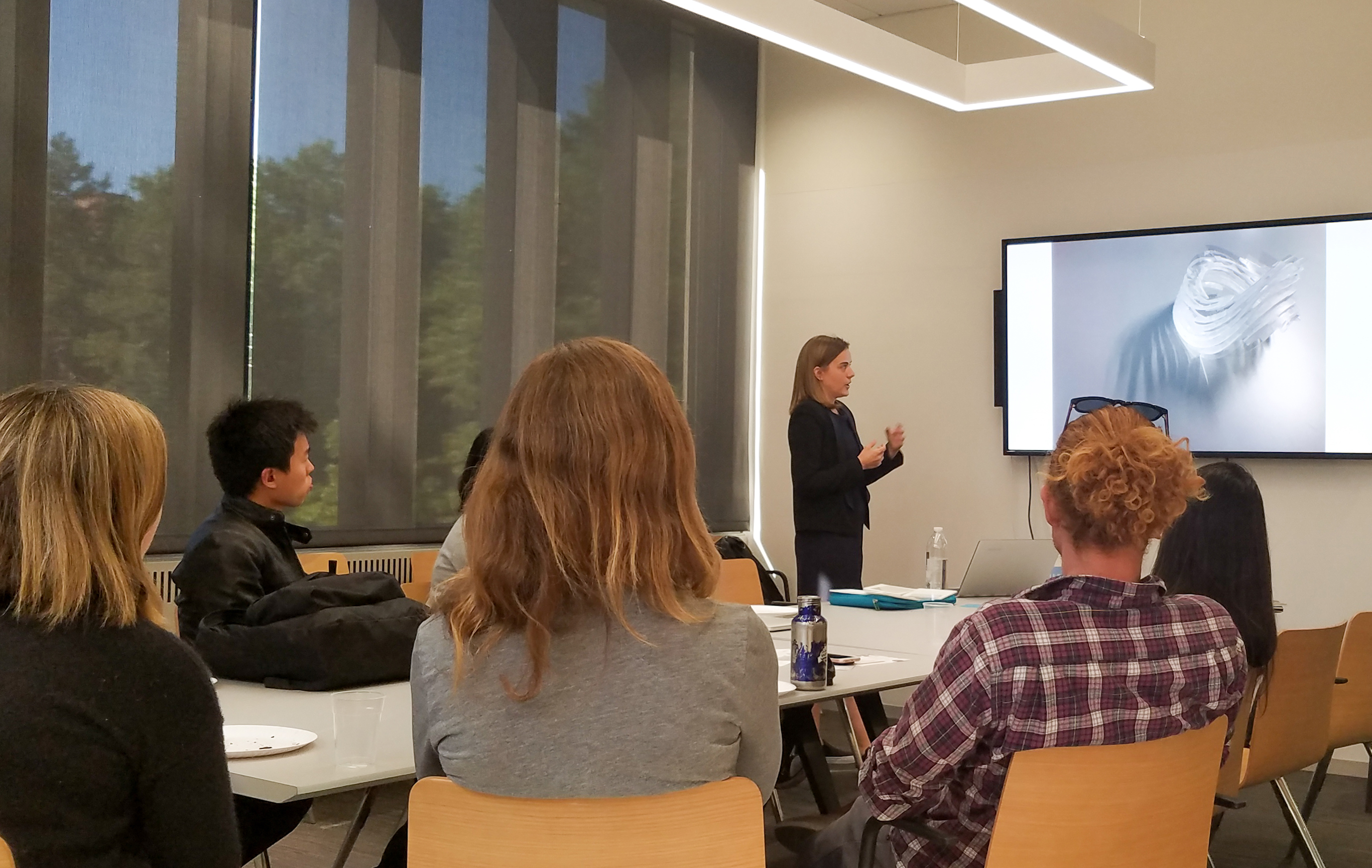
What advice would she give to engineering students looking to create art? “Maintain a project-oriented mindset,” she says. She cites her experience as a project manager in practice as crucial to the management of this independent project. These skills include risk management and time management. Her experience as a PM also enabled her to effectively engage with her collaborators; her work was additionally supported by Corning Inc. and Coresix Inc. “At one point my collaborators nearly dropped the project because it was too expensive. I made many phone calls and was eventually able to negotiate a compromise.”
On a more personal level, Pennetier encourages engineering students to “recognize the fun. Find what makes you feel alive; that kind of motivation will take you far. Engineers rarely take the artistic path, so don’t be afraid to let your crazy idea bloom.”


